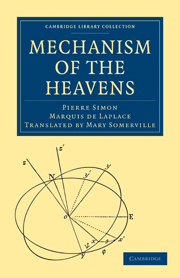Book contents
- Frontmatter
- PRELIMINARY DISSERTATION
- PHYSICAL ASTRONOMY
- BOOK I
- BOOK II
- CHAPTER I PROGRESS OF ASTRONOMY
- CHAPTER II ON THE LAW OF UNIVERSAL GRAVITATION, DEDUCED FROM OBSERVATION
- CHAPTER III ON THE DIFFERENTIAL EQUATIONS OF THE MOTION OF A SYSTEM OF BODIES, SUBJECTED TO THEIR MUTUAL ATTRACTIONS
- CHAPTER IV ON THE ELLIPTICAL MOTION OF THE PLANETS
- CHAPTER V THEORY OF THE PERTURBATIONS OF THE PLANETS
- CHAPTER VI SECULAR INEQUALITIES IN THE ELEMENTS OF THE ORBITS
- CHAPTER VII PERIODIC VARIATIONS IN THE ELEMENTS OF THE PLANETARY ORBITS
- CHAPTER VIII PERTURBATIONS OF THE PLANETS IN LONGITUDE, LATITUDE, AND DISTANCE
- CHAPTER IX SECOND METHOD OF FINDING THE PERTURBATIONS OF A PLANET IN LONGITUDE, LATITUDE, AND DISTANCE
- CHAPTER X THE THEORY OF JUPITER AND SATURN
- CHAPTER XI INEQUALITIES OCCASIONED BY THE ELLIPTICITY OF THE SUN
- CHAPTER XII PERTURBATIONS IN THE MOTIONS OF THE PLANETS OCCASIONED BY THE ACTION OF THEIR SATELLITES
- CHAPTER XIII DATA FOR COMPUTING THE CELESTIAL MOTIONS
- CHAPTER XIV NUMERICAL VALUES OF THE PERTURBATIONS OF JUPITER
- BOOK III
- BOOK IV
- Index
- Errata
CHAPTER X - THE THEORY OF JUPITER AND SATURN
Published online by Cambridge University Press: 29 August 2010
- Frontmatter
- PRELIMINARY DISSERTATION
- PHYSICAL ASTRONOMY
- BOOK I
- BOOK II
- CHAPTER I PROGRESS OF ASTRONOMY
- CHAPTER II ON THE LAW OF UNIVERSAL GRAVITATION, DEDUCED FROM OBSERVATION
- CHAPTER III ON THE DIFFERENTIAL EQUATIONS OF THE MOTION OF A SYSTEM OF BODIES, SUBJECTED TO THEIR MUTUAL ATTRACTIONS
- CHAPTER IV ON THE ELLIPTICAL MOTION OF THE PLANETS
- CHAPTER V THEORY OF THE PERTURBATIONS OF THE PLANETS
- CHAPTER VI SECULAR INEQUALITIES IN THE ELEMENTS OF THE ORBITS
- CHAPTER VII PERIODIC VARIATIONS IN THE ELEMENTS OF THE PLANETARY ORBITS
- CHAPTER VIII PERTURBATIONS OF THE PLANETS IN LONGITUDE, LATITUDE, AND DISTANCE
- CHAPTER IX SECOND METHOD OF FINDING THE PERTURBATIONS OF A PLANET IN LONGITUDE, LATITUDE, AND DISTANCE
- CHAPTER X THE THEORY OF JUPITER AND SATURN
- CHAPTER XI INEQUALITIES OCCASIONED BY THE ELLIPTICITY OF THE SUN
- CHAPTER XII PERTURBATIONS IN THE MOTIONS OF THE PLANETS OCCASIONED BY THE ACTION OF THEIR SATELLITES
- CHAPTER XIII DATA FOR COMPUTING THE CELESTIAL MOTIONS
- CHAPTER XIV NUMERICAL VALUES OF THE PERTURBATIONS OF JUPITER
- BOOK III
- BOOK IV
- Index
- Errata
Summary
571. By comparing ancient with modern observations, Halley discovered that the mean motion of Jupiter had been accelerated, and that of Saturn retarded. Halley, Euler, La Grange, La Place, and other eminent mathematicians, were led by their researches to the certain conclusion that these inequalities do not depend on the configuration of the orbits; and as La Place proved that they are not occasioned by the action of comets, or bodies foreign to the system, he could only suppose them to belong to the class of periodic inequalities.
Observation had already shown that five times the mean motion of Saturn is so nearly equal to twice the mean motion of Jupiter, that the difference of these two quantities, or 5n′ – 2n, is an extremely small fraction, being about the 74th part of the mean motion of Jupiter. La Place perceived that the square of this minute quantity is divisor to some of the perturbations in the longitude of Jupiter and Saturn, which led him to conjecture that the nearly commensurable ratio in the mean motions might be the cause of this anomaly in the theory of these two planets ; a conjecture which computation amply confirmed, showing that a great inequality of 48′ 2″.207 at its maximum exists in the theory of Saturn, which at the present time increases the mean motion of the planet, and accomplishes its changes in about 929 years; and that the mean motion of Jupiter is also affected by a corresponding and contrary inequality of nearly the same period, only amounting to 19′ 46″.62 at its maximum, which diminishes the mean motion of Jupiter.
Information
- Type
- Chapter
- Information
- Mechanism of the Heavens , pp. 324 - 342Publisher: Cambridge University PressPrint publication year: 2009First published in: 1831
